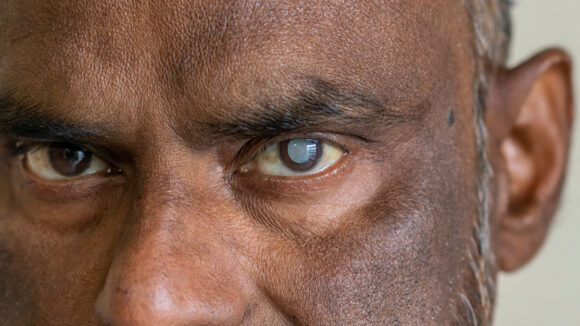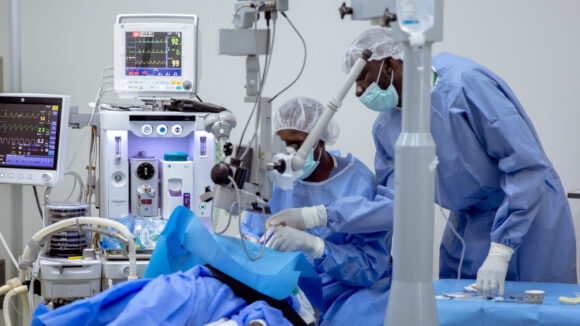Cataracts are the world’s leading cause of blindness. Find out about the causes and common symptoms of cataracts, and learn how they can be treated.
Cataracts: causes, symptoms and treatment
What are cataracts?
The clear lens at the front of the eye is made from special proteins. Cataracts form when these proteins break down and create cloudy patches on the lens. Over time the patches can grow bigger, causing blurry vision.
The main types of cataracts are:
- Age-related cataracts: older adults are more susceptible to developing them
- Congenital cataracts: children can be born with cataracts in one or both eyes, which can lead to permanent blindness if left untreated
- Trauma-related cataracts: an injury to the eye as a result of an impact or a sharp penetration can cause them to form
Cataracts can form on different parts of the lens. Cataracts that develop in the centre of the eye, called ‘nuclear cataracts’, are most common.

How do cataracts affect vision?
What does the world look like when you have cataracts? Our simulator will give you an idea.
Try the simulatorWhat causes cataracts?
A cataract develops when protein in the eye’s lens builds up to form a layer. This natural process happens gradually as we age. It can lead to blurred vision and eventual blindness. Cataracts can also form as a result of trauma to the eye.
Risk factors that can increase your chances of developing cataracts include:
- Age: people over 50 years old are most at risk
- Genetics: having family members with the condition
- Lifestyle: smoking, drinking alcohol and spending time in the sun without wearing sunglasses
- Health conditions: diabetes and other health issues
- Medication: certain medicines can increase the likelihood of cataracts
What are the symptoms of cataracts?
You may not notice any changes in your vision when a cataract first develops. But as it becomes denser, you’re likely to experience some visible signs.
Common signs of cataracts include:
- Changes to the colour of the pupil – it may look white
- Blurred, dim or misty vision
- Difficulty seeing in low light or at night
- Sensitivity to light: lights look too bright or glaring
- Colours look faded or muted
- Seeing a ‘halo’ around bright lights
- Everything looks more ‘washed out’
If you have cataracts, things can start to look dim, blurred or distorted, as if you’re looking through dirty glass. Your vision may seem cloudy, and it can also be hard to make out details or colours.
Source: Lancet Global Health Commission on Global Eye Health (2021)
How are cataracts diagnosed and treated?
If you have cataract symptoms, it’s important to visit a doctor for a diagnosis so you can be treated. You may also be diagnosed by an optometrist during a routine eye test, which should take place every two years.
During your eye exam, an eye specialist may test your vision by asking you to read letters or symbols from a chart and by performing a close check of your eyes to see if the lens has become cloudy.
Prescription glasses or contact lenses can help improve a person’s eyesight during the early stages of cataracts. However, it’s still important to seek further treatment, such as surgery, to prevent permanent sight loss.
Cataract surgery is the only way to restore vision. The operation is straightforward and effective. It involves removing the clouded lens from the lens capsule and replacing it with an artificial one. A patient’s vision starts to return within a few hours of surgery. Learn more about cataract surgery
Benefits of cataract surgery include:
- Improved or restored eyesight
- Reduced glare or halos in your vision
- Improved quality of life

Cataract surgery
An operation to treat cataracts can take as little as 20 minutes, and a person’s vision can start to return a few hours after surgery.
About cataract surgeryHow Sightsavers is helping to treat cataracts
In collaboration with partners, our work makes it easier for people in Africa and Asia to be examined and treated for cataracts.
- We help develop quality eye care services so people can have their eyes checked and can be referred for free treatment if needed
- We train eye surgeons, nurses and community workers to improve the quality of cataract surgery and make sure more operations can be carried out
- We run health programmes in local communities to educate people about cataracts and explain where they can get treatment